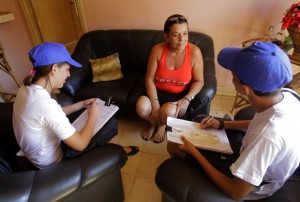CUBA EN NÚMEROS: Lo que el Censo nos dejó.
Los Censos de Población y Viviendas constituyen la investigación estadística más importante que realiza un país y una de las más trascendentes en el campo social, teniendo en cuenta su utilidad.
El Censo del año 2012, levantado en Cuba en el período del 15 al 24 de septiembre, definió a su vez como momento censal las 24:00 horas del día anterior, 14 de septiembre, y actualizó las cifras del Censo anterior que fue levantado exactamente 10 años antes en septiembre del año 2002.
La población obtenida en el censo del 2012 fue de 11 167 325 habitantes. Según provincia, La Habana es la más poblada con 2 106 646 habitantes y Mayabeque la de menor número de habitantes con 376 825. Otras provincias con más de un millón de habitantes lo son Santiago de Cuba y Holguín con 1 049 084 y 1 035 072 respectivamente.
Comenzando hoy estaremos informado de las características sociales nacionalmente en números proporcionados por el Censo:
Empezando hoy por:
• El color de la piel.
La composición de la población atendiendo al color de la piel, permitió constatar la tendencia observada en el censo del 2002 y anteriores en lo que se refiere a la disminución de los porcentajes de población blanca y negra, que en ese conteo censal ascendían a 65,0% y 10,1% respectivamente. En el censo del 2012, el por ciento de población blanca disminuyó a 64,1%, y el de la población negra al 9,3%. Por el contrario la población mestiza pasó del 24,9% al 26,6%, ratificando la tendencia al aumento de este grupo de la población.
Las provincias de Sancti Spíritus, Villa Clara y Holguín reúnen los más altos por cientos de población de color de la piel blanca con valores iguales o superiores al 80%, mientras que en Guantánamo y Santiago de Cuba se registran las más bajas proporciones, que representan aproximadamente el 25% de su población total. A su vez, en las provincias de La Habana y Santiago de Cuba residen las más altas proporciones de población de color de la piel negra, con el 15,2 y 14,2% respectivamente. Por su parte la población mestiza es
mayoritaria en Guantánamo, Santiago de Cuba y Granma con el 62,8; 60,2 y 54,3% de la población total respectivamente.
A nivel de los municipios se observa que en Cabaigüán, Gibara, Florencia y Taguasco se concentran porcentajes de población de color de la piel blanca por encima del 90%, mientras que en Niceto Pérez y Songo La Maya, se ubican los más bajos. En Songo-La Maya y La Habana Vieja residen las más altas proporciones de población negra del país del orden de 23,6% y 20,1%, y en San Antonio del Sur y Yateras las de población mestiza con el 77,8 y 77,0 del total
Cuba Debate/InternetPhotos/www.thecubanhistory.com
CUBA IN NUMBERS: What the Census Let us Know.
The CUban History, Hollywood.
Arnoldo Varona, Editor
CUBA IN NUMBERS : What the Census let us know.
The Census of Population and Housing is the most important statistical research that takes a country and one of the most significant in the social field , considering its usefulness.
The Census of 2012, raised in Cuba in the period 15 to 24 September , in turn defined as census time 24:00 above, on September 14 , and updated the figures for the previous Census was raised exactly 10 years before in September 2002.
The population obtained in the census of 2012 was 11,167,325 inhabitants. According province , La Habana is the most populated with 2,106,646 inhabitants and Mayabeque the smallest population of 376 825. Other provinces with more than one million people are Santiago de Cuba and Holguin 1,049,084 and 1,035,072 respectively .
Starting today we will be informed of the social characteristics nationally on numbers provided by the Census :
Beginning today :
• The color of the skin.
The composition of the population in response to the color of the skin, helped to confirm the trend observed in the 2002 census and earlier in regards to decreasing percentages of white and black population , which at the census count totaled 65, 0 % and 10.1% respectively. In the census of 2012 , the percentage of white population decreased to 64.1 % and the black population to 9.3 %. By contrast the mestizo population increased from 24.9% to 26.6 % , confirming the upward trend of this population group .
The provinces of Sancti Spiritus , Villa Clara and Holguin meet the highest percentages of people of white skin color with values equal to or greater than 80%, while in Guantanamo and Santiago de Cuba the lowest proportions were recorded representing approximately 25% of its total population. In turn, in the provinces of Havana and Santiago de Cuba reside the highest proportions of people of color in the black leather , with 15.2 and 14.2 % respectively. Meanwhile the population is mestizo majority in Guantanamo, Santiago de Cuba and Granma with 62.8 ; 60.2 and 54.3% respectively of the total population .
At the municipal level is observed in Cabaiguán , Gibara , Florence and Taguasco population percentages of the white skin color are concentrated above 90 % , while in Nicetas Perez and Songo La Maya, are located lower . In Songo -La Maya and Havana Vieja reside higher proportions of black population in the order of 23.6% and 20.1 % , and in San Antonio and South Yateras the mestizo population and 77.8 total 77.0
Cuba Debate / InternetPhotos / www.thecubanhistory.com
CUBA IN NUMBERS : What the Census Let us Know .
The Cuban History , Hollywood.
Arnoldo Varona , Editor




